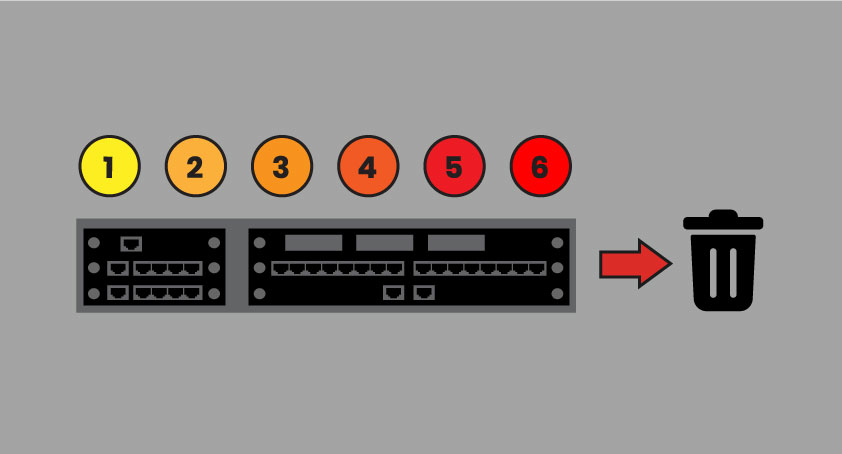6 Signs it’s Time to Replace Your PBX Box

An onsite PBX (Private Branch Exchange) box used to mean freedom from the shackles of the long-term contracts and poor support provided by traditional business phone companies. But as times changed and the business phone system landscape changed along with it, you'll be excited to know that there are new options for managing the phone software for your business. Remember, just because it's the phone system you know doesn't mean it should be your phone system forever.
PBX boxes typically last 10-15 years and require, on average, 25 hours of service a month. If your box was bought prior to 2010 or if you haven't maintained it properly, you may want to brew some soothing tea and read on.
Fixing your broken PBX box is often costly and time-consuming. Worse still, it simply kicks the can down the road since they never work as well again after they break once. That's why it's important to know the warning signs of when it's time to start looking around for what's next.
1. At least one feature of your phone system is always down
One of the most frustrating, and difficult to manage aspects of PBX boxes is that they generally don’t just die. Instead, individual components will fail, causing different features to stop working while the rest of your phone system appears normal.
For instance, your voicemail may stop recording messages, but because calls keep coming in you won’t find out until the Tuesday after a long weekend and you wonder why your voicemail has no messages...
Or your inbound calls may come through just fine, but all you get is dead air when you try to place a call.
These types of problems only get worse as PBX boxes age. Yes, you can continue replacing the different components like the world’s most expensive jigsaw puzzle, but frequent outages or feature loss is a sure sign that the underlying switchboard and line trunks are failing. When that happens, you’ll have to throw the whole thing out and start over again from scratch.
Rather than just bracing for the inevitable day your phones go dark, I suggest taking a proactive approach to replacing your PBX as soon as failures or service outages start. Make a list of features and functionality your team wants from your phone system, and then do some sleuthing to see what the best price would be. By not waiting until your communications are down and it's an all-hands-on-deck emergency, you’re much more likely to improve your phone system instead of just replacing it.
2. You’re not even afraid of the dark, creepy PBX box room anymore
The #1 difference between a good phone system and a bad one is how much you know about it. If you know too much about it, that means there’s a problem. Hear me out…
If your PBX box works just how you expect, there’s no reason for you to ever even look at it. It remains a love-craftian enigma, buried deep in the basement or in a forgotten closet at the end of a dark hallway.
However, if your business phone system is constantly causing problems, you’re all too familiar with your PBX box. You’ve made the journey to its closet or basement corner so many times that you don’t even turn on the lights anymore. You know every clunky component, every bundle of phone lines.
You shouldn’t need to become an amateur IT tech just to use your desk phone. By switching to a cloud-hosted VoIP system, you move everything—the box, the wires, the maintenance, the support—out of your office and out of your hair so you can focus solely on running your business.
3. Your company needs more than the basic communications features
Let’s give your PBX box the benefit of the doubt and assume it’s still working like a champion. You can make and receive calls just fine, transfer calls, check your voicemail, and… and that’s about it. Even at its best, a PBX box is still outdated and lackluster compared to what modern phone systems can accomplish.
With a cloud-hosted solution, you can:
• Use your computer as a phone
• Forward calls to your personal device
• Text customers from your work number
• Integrate your system directly with your CRM
• Receive transcribed voicemails as emails
The list goes on, and on, but you get the idea. The best part is, all those advanced features can be added or updated in minutes without you having to lift a finger.
How many times have you called your IT consultant, had to wait a few days for them to be available, and then spent a small fortune just for them to make minor changes to your PBX setup? If just reading that sentence made your eye twitch, it’s time to update your phone system.
4. You’re constantly on the phone with IT
Don’t get me wrong, I have nothing against IT professionals. I myself spent some time on our support team. But the thing about IT is, they’re meant to be the Scooby Doo Gang of the business world. They show up, reveal your culprit, and then disappear back into the night.
So if you find yourself constantly on the phone with IT about your PBX box, or they’re around the office so much your staff mistakes them for a new employee, your phone system is officially on the decline. Managing your phone system should be easy and only occasionally take a few minutes of your day to update. It should not require scheduled calls with IT or so much time you start falling behind on your regular work.
Getting IT help with PBX boxes is especially difficult (and expensive) because their archaic designs require specific expertise to fix. Even for a seasoned professional, diagnosing which clunky part or wire is at fault takes time. And especially when it comes to IT work, time is money. Even worse, as technology advances the knowledge needed to fix PBX boxes will only get harder and more costly to find.
5. Replacement Parts are No Longer Produced
On-premises PBX Boxes used to be considered technical wizardry, the peak of business communications. Unfortunately for businesses still using them, that was in the 1960’s. Is there anything else from the 60’s still in your office (besides maybe your boss)? Even if there was, can you imagine finding parts for it that still work (unlike maybe your boss)?
Ordering new parts for your PBX box is difficult and expensive in most cases, but with some models has become downright impossible. If new parts for your PBX Box are no longer available, it’s a good idea to look into switching now, before it becomes an emergency. Plus, even if you do find a new part, you have to find and pay someone with the IT experience to install it. Plus, you have to factor in the cost of all the potential business you lost waiting for your phone system to get up and running again.
One of the oldest rules of business is to ignore sunk costs when making new decisions.You don’t need to keep fixing your PBX box forever just because you invested in it and kept it going through all the years it was your only option. It’s 2020 now, and there are tons of cheaper, easier, feature-packed options for your business.
6. You spend more money on annual maintenance than the PBX Box is worth
Setting up a new on-premises PBX phone system for your company isn’t cheap--usually in the neighborhood of a couple thousand dollars. Unfortunately, according to HomeAdvisor, that initial investment pales in comparison to the $7,200 it costs to maintain and repair an aging PBX box every single year. That number doesn’t even include the cost of your actual phone service.
I know the idea of switching to a new phone system isn’t appealing. No one (except all of us here at FluentStream!) wakes up excited to talk about extension numbers and call routing. However, when replacing your PBX box can save you thousands of dollars and days of hassle every single year, the choice becomes pretty easy.
An onsite PBX (Private Branch Exchange) box used to mean freedom from the shackles of the long-term contracts and poor support provided by traditional business phone companies. But as times changed and the business phone system landscape changed along with it, you'll be excited to know that there are new options for managing the phone software for your business. Remember, just because it's the phone system you know doesn't mean it should be your phone system forever.
PBX boxes typically last 10-15 years and require, on average, 25 hours of service a month. If your box was bought prior to 2010 or if you haven't maintained it properly, you may want to brew some soothing tea and read on.
Fixing your broken PBX box is often costly and time-consuming. Worse still, it simply kicks the can down the road since they never work as well again after they break once. That's why it's important to know the warning signs of when it's time to start looking around for what's next.
1. At least one feature of your phone system is always down
One of the most frustrating, and difficult to manage aspects of PBX boxes is that they generally don’t just die. Instead, individual components will fail, causing different features to stop working while the rest of your phone system appears normal.
For instance, your voicemail may stop recording messages, but because calls keep coming in you won’t find out until the Tuesday after a long weekend and you wonder why your voicemail has no messages...
Or your inbound calls may come through just fine, but all you get is dead air when you try to place a call.
These types of problems only get worse as PBX boxes age. Yes, you can continue replacing the different components like the world’s most expensive jigsaw puzzle, but frequent outages or feature loss is a sure sign that the underlying switchboard and line trunks are failing. When that happens, you’ll have to throw the whole thing out and start over again from scratch.
Rather than just bracing for the inevitable day your phones go dark, I suggest taking a proactive approach to replacing your PBX as soon as failures or service outages start. Make a list of features and functionality your team wants from your phone system, and then do some sleuthing to see what the best price would be. By not waiting until your communications are down and it's an all-hands-on-deck emergency, you’re much more likely to improve your phone system instead of just replacing it.
2. You’re not even afraid of the dark, creepy PBX box room anymore
The #1 difference between a good phone system and a bad one is how much you know about it. If you know too much about it, that means there’s a problem. Hear me out…
If your PBX box works just how you expect, there’s no reason for you to ever even look at it. It remains a love-craftian enigma, buried deep in the basement or in a forgotten closet at the end of a dark hallway.
However, if your business phone system is constantly causing problems, you’re all too familiar with your PBX box. You’ve made the journey to its closet or basement corner so many times that you don’t even turn on the lights anymore. You know every clunky component, every bundle of phone lines.
You shouldn’t need to become an amateur IT tech just to use your desk phone. By switching to a cloud-hosted VoIP system, you move everything—the box, the wires, the maintenance, the support—out of your office and out of your hair so you can focus solely on running your business.
3. Your company needs more than the basic communications features
Let’s give your PBX box the benefit of the doubt and assume it’s still working like a champion. You can make and receive calls just fine, transfer calls, check your voicemail, and… and that’s about it. Even at its best, a PBX box is still outdated and lackluster compared to what modern phone systems can accomplish.
With a cloud-hosted solution, you can:
- Use your computer as a phone
- Forward calls to your personal device
- Text customers from your work number
- Integrate your system directly with your CRM
- Receive transcribed voicemails as emails
The list goes on, and on, but you get the idea. The best part is, all those advanced features can be added or updated in minutes without you having to lift a finger.
How many times have you called your IT consultant, had to wait a few days for them to be available, and then spent a small fortune just for them to make minor changes to your PBX setup? If just reading that sentence made your eye twitch, it’s time to update your phone system.
4. You’re constantly on the phone with IT
Don’t get me wrong, I have nothing against IT professionals. I myself spent some time on our support team. But the thing about IT is, they’re meant to be the Scooby Doo Gang of the business world. They show up, reveal your culprit, and then disappear back into the night.
So if you find yourself constantly on the phone with IT about your PBX box, or they’re around the office so much your staff mistakes them for a new employee, your phone system is officially on the decline. Managing your phone system should be easy and only occasionally take a few minutes of your day to update. It should not require scheduled calls with IT or so much time you start falling behind on your regular work.
Getting IT help with PBX boxes is especially difficult (and expensive) because their archaic designs require specific expertise to fix. Even for a seasoned professional, diagnosing which clunky part or wire is at fault takes time. And especially when it comes to IT work, time is money. Even worse, as technology advances the knowledge needed to fix PBX boxes will only get harder and more costly to find.
5. Replacement Parts are No Longer Produced
On-premises PBX Boxes used to be considered technical wizardry, the peak of business communications. Unfortunately for businesses still using them, that was in the 1960’s. Is there anything else from the 60’s still in your office (besides maybe your boss)? Even if there was, can you imagine finding parts for it that still work (unlike maybe your boss)?
Ordering new parts for your PBX box is difficult and expensive in most cases, but with some models has become downright impossible. If new parts for your PBX Box are no longer available, it’s a good idea to look into switching now, before it becomes an emergency. Plus, even if you do find a new part, you have to find and pay someone with the IT experience to install it. Plus, you have to factor in the cost of all the potential business you lost waiting for your phone system to get up and running again.
One of the oldest rules of business is to ignore sunk costs when making new decisions.You don’t need to keep fixing your PBX box forever just because you invested in it and kept it going through all the years it was your only option. It’s 2020 now, and there are tons of cheaper, easier, feature-packed options for your business.
6. You spend more money on annual maintenance than the PBX Box is worth
Setting up a new on-premises PBX phone system for your company isn’t cheap--usually in the neighborhood of a couple thousand dollars. Unfortunately, according to HomeAdvisor, that initial investment pales in comparison to the $7,200 it costs to maintain and repair an aging PBX box every single year. That number doesn’t even include the cost of your actual phone service.
I know the idea of switching to a new phone system isn’t appealing. No one (except all of us here at FluentStream!) wakes up excited to talk about extension numbers and call routing. However, when replacing your PBX box can save you thousands of dollars and days of hassle every single year, the choice becomes pretty easy.
Visited 801 Times, 2 Visits today


